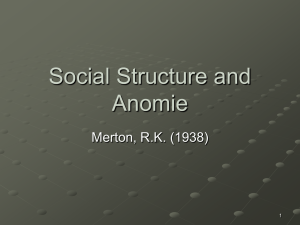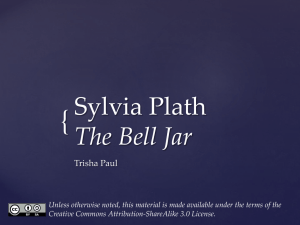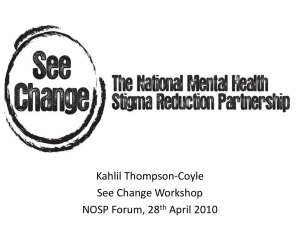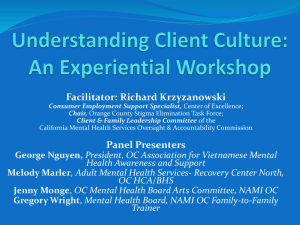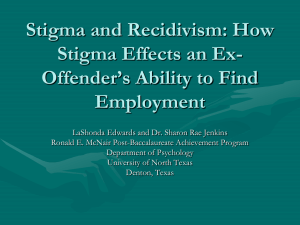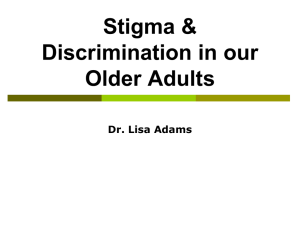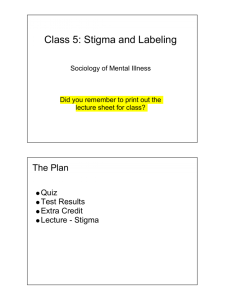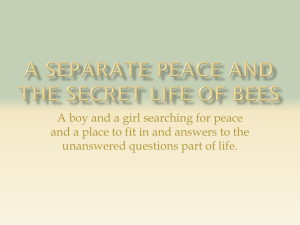Stigma - Deviance & Social Pathology
advertisement
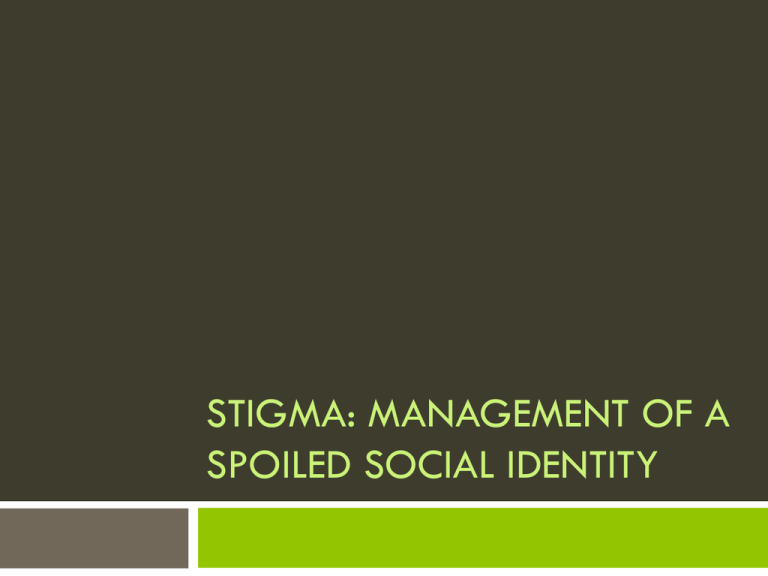
STIGMA: MANAGEMENT OF A SPOILED SOCIAL IDENTITY Symbolic interactionism Symbolic interactionism is a micro-level theory based on the idea that people act in accordance with shared meanings, orientations, and assumptions Herbert Blumer, a student of Mead, coined term and put forward an influential summary of the perspective: people act toward things based on the meaning those things have for them; and these meanings are derived from social interaction and modified through interpretation. Labeling theory builds on symbolic interactionist principles 2 Labeling theory Labeling theory: how public labeling, or branding, as deviant, has adverse consequences for further social participation and self-image most critical change is in public identity, which is a crucial step towards building a long-term deviant ‘career’ If ‘master status’ is deviant, deviant identification becomes the controlling one master status: a status that assumes priority, overrides other status consideration Labeling may be a ‘self-fulfilling prophecy’ ‘…possession of one deviant trait may have a generalized symbolic value, so that people automatically assume that its bearer possesses other undesirable traits allegedly associated with it’ – i.e., auxiliary traits Consequences: exclusion from participation in most conventional groups “treatments” (medication, institutionalization, incarceration, etc.) which may themselves produce increasing deviance 3 "Stigma is a process by which the reaction of others spoils normal identity" 4 Greeks originated the term for "bodily signs designed to expose something unusual and bad about the moral status of the signifier” signs cut or burned into the body, advertising bearer was a slave, criminal, or a traitor - a blemished person, ritually polluted, to be avoided, esp in public places Today, term is applied more to disgrace itself, than to bodily evidence of it Shifts occur in the kinds of disgrace that arouse concern Society has a way grouping people into social categories, each with a set of typical attributes Whenever we meet someone new, we use our experience to anticipate his/her category & attributes, his/her social identity a person’s virtual social identity refers to the anticipated category and attributes a person's actual social identity is their actual category and attributes 5 Stigma Stigma is a discrepancy between actual and virtual social identity that causes us to alter our estimation of them downward Stigma is an attribute that is deeply discrediting – but it depends on circumstances an attribute that stigmatizes one person may be typical for another person and is therefore neither creditable nor discreditable in itself e.g., some jobs cause employees w/o the expected college education to hide this fact; other jobs, however, can lead employees with a degree to keep it a secret, so that they aren't seen as outsiders e.g., a middle class boy may have no problem being seen going to the library, whereas a gang member may worry about being seen by his associates Stigma is really a special kind of relationship between attribute and stereotype 6 How do stigmatized deal with stigma? 7 1) attempt to correct what he sees as objective basis of failing disfigured person gets plastic surgery blind person gets eye treatment gay person gets psychotherapy (in 1963) not transformation to someone ‘normal’ but someone with a record of having corrected a particular blemish susceptibility to victimization, exploitation by quacks 2) devote private effort to mastering areas of activity felt to be closed e.g., wheelchair basketball 3) use stigma as an explanation for all social failings 4) see suffering as a ‘blessing in disguise’ (11) 5) re-assess limitations of ‘normals’ normal people, do they really see, hear.? (top 12) Mixed contacts 8 Mixed contacts: the moments when stigmatized individual (SI) and normal (N) are in same "social situation," in immediate physical presence, whether in conversation-like encounter or mere co-presence at unfocused gathering Anticipation of uncomfortable scenario may lead N & SI to avoid them self-isolation (top 13) When they are forced to interact you get ‘primal scenes of sociology,’ cause & effect of stigma must be directly confronted by both sides SI feels unsure of how Ns will react, ‘uncertainty of status’ (bot 13) SI must be ‘on’ all the time, self-conscious and calculating about the impression s/he is making – the opposite of ‘sociability’ (Simmel) SI may respond with ‘defensive cowering’ (17) SI may respond with ‘hostile bravado’ (17-18) Ns uncomfortable too, finding SI either too aggressive or too shamefaced, and always too ready to read unintended meanings into our actions The ‘pathology of interaction’ 9 Mead neglects ‘pathological’ interaction and how we manage it ‘Each potential source of discomfort for him when we are with him can become something we sense he is aware of, aware that we are aware of, and even aware of our state of awareness about his awareness; the stage is then set for the infinite regress of mutual consideration that Meadian social psychology tells us how to begin but not how to terminate.’ (18) ‘infinite regress of mutual consideration’ ‘In consequence, attention is furtively withdrawn from its obligatory targets, and self-consciousness and "otherconsciousness" occurs, expressed in the pathology of interaction—uneasiness.’ (18) The discredited and the discreditable When one possesses a stigma that is ‘known about,’ s/he is discredited i.e., when SI’s failing can be perceived by merely directing attention (typically visual) to him/her e.g., physical deformity or disability Focus turns to managing tension in interactions with normals If the stigma is not known about, s/he is discreditable e.g., mental illness, medical/criminal history Focus turns to managing undisclosed information about a supposed failing - passing 10 Passing 11 'Passing' is when people with a stigma that is not known about (the discreditable) 'pass' for 'normals' The discreditable may attempt to conceal their stigmatizing attributes in a conscious strategy to pass Symbols – of prestige & stigma 12 Symbols are signs that convey social information prestige symbol (aka, status symbol) coveys social information about an individual indicating prestige, honor, or desirable class position stigma symbol are signs drawing attention to a debasing identity discrepancy, which reduce society’s valuation of the individual Disidentifier A third type of sign is a disidentifier disidentifiers are signs intended to break up an otherwise coherent picture, but in a positive direction desired by the actor actor attempts to undermine social stereotypes about him/her by displaying some symbol (disidentifier) that doesn’t fit with the stereotype, e.g., a homeless person reads a newspaper or book in an attempt to stay the night in some public space putting on glasses in an attempt to look more “intellectual” putting on “religious” attire in an attempt to feign belief taking off “religious” attire in an attempt to disguise belief 13 The Self and its Other (Ch. IV) 14 Some may think that established minority groups (e.g., blacks, Jews) should be the object of analysis, but the key issue is their place in the social structure, which requires analysis of the history, politics, and current policies of the group contingencies encountered in F2F interaction is only part of the problem ‘The most fortunate of normals is likely to have a half-hidden failing, and for every little failing there is a social occasion when it will loom large, creating a shameful gap between virtual and actual social identity. Therefore, the occasionally precarious and constantly precarious form a single continuum, their situation analyzable by the same framework.’ (127) We should look to the ordinary for an understanding of differentness ‘The question of social norms is certainly central, but the concern might be less for uncommon deviations from the ordinary than for ordinary deviations from the common.’ (127) Stigma vs. Deviance 15 Deviance is not complying with norms Stigma involves violation of norms of special kind, norms concerning identity or being ‘It is a question of the individual's condition, not his will; it is a question of conformance, not compliance.’ (128) Some norms take form of ideals and constitute standards against which almost everyone falls short at some stage in life… 16 ‘For example, in an important sense there is only one complete unblushing male in America: a young, married, white, urban, northern, heterosexual Protestant father of college education, fully employed, of good complexion, weight, and height, and a recent record in sports. Every American male tends to look out upon the world from this perspective, this constituting one sense in which one can speak of a common value system in America. Any male who fails to qualify in any of these ways is likely to view himself--during moments at least--as unworthy, incomplete, and inferior; at times he is likely to pass and at times he is likely to find himself being apologetic or aggressive concerning known-about aspects of himself he knows are probably seen as undesirable. The general identity-values of a society may be fully entrenched nowhere, and yet they can cast some kind of shadow on the encounters encountered everywhere in daily living.’ (128) Culture, subcultures 17 Culture: shared understandings and their representations in symbols or practices (Tilly, 2005) Subculture: a cultural group within a larger culture with shared understandings and practices at variance with those of the larger culture a subculture is a subdivision of a national culture Sociology Factsheet on ‘Youth Subcultures,’ in the UK highlights ‘goths,’ ‘emos,’ and ‘chavs’ Styles draw on American culture, but meanings are somewhat different in UK Chav, per Sociology Factsheet on ‘Youth Subcultures,’Curriculum Press, UK 18 “This refers to a subculture which originated from within the working class culture of England. Chav fashion is derived from American hip hop (African American) and Guido (Italian-American) fashions and stereotypes such as gold jewelry and designer clothing combined with elements of working class British street fashion. The defining features of the chav clothing is the Burberry pattern (notably a now discontinued baseball cap) and from a variety of other casual and sportswear brands. Tracksuits, hoodies and baseball caps are particularly associated with this stereotype. Lauren Cooper who is played by Catherine Tate in the Catherine Tate show, is a stereotype of a chav female. They aspire to the latest mobile phone and other accessories. They tend to have a dislike of goths and emos as well as other ‘alternative’ subcultures.” What’s the ‘chav-bashing’ all about? 19 In Chavs: The Demonization of the Working Class, Owen Jones argues: ‘The word “chav” has become a way to stereotype a vast underprivileged section of our society. It’s a term that has become synonymous with the white working class, a way of rationalizing inequality. After all, if the working class is full of spendthrift layabouts who lack aspiration, then social programs aimed at poverty reduction become a waste of time and money.’ Just the latest object of middle-class derision & moral superiority? Does contempt reveal more about the detractors? Status anxiety? Is this racism? targets are generally white, but ‘whites [who’ve] become black,’ as British historian David Starkey put it in response to the UK riots of August 2011 How do racial/class politics in UK compare to US?
